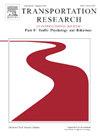注视策略和认知负荷对驾驶员在与弱势道路使用者发生潜在冲突时右转保护行为的影响
IF 4.4
2区 工程技术
Q1 PSYCHOLOGY, APPLIED
Transportation Research Part F-Traffic Psychology and Behaviour
Pub Date : 2025-02-01
DOI:10.1016/j.trf.2024.11.012
引用次数: 0
摘要
在城市交通中,虽然涉及弱势道路使用者(VRU)的碰撞比例较低,但由于VRU的伤害风险较高,其重要性很高。相对于司机和vru更常见的个人感知和行为错误而言,这些错误的平均发生率较低反映了交通过程中潜在的容错能力。然而,在不同的交通情况下,容错的程度是不同的。所涉及的潜在感知和认知过程是复杂的,可能需要高度的注意力和集中,特别是在有交叉轨迹的情况下。这些过程偶尔会失败,从而导致碰撞风险。右转的驾驶者(在右行驶的国家)遇到骑车者在自行车道上直行(有先行权)的情况,容错度特别低,因为驾驶者必须主动扫描从后面接近的骑车者。为了开发、测试和评估在这种情况下降低碰撞风险的解决方案,需要调查与行为相关的因果机制。这是本文的重点。我们在封闭的测试跑道上进行了一项试验,共有35名受试者。实验设计为受试者内设计,有三个独立的因素:n-back任务中的机动、目标速度和认知负荷。该试验包括观察参与者的凝视控制。本研究主要关注被试保护凝视行为的质量和效率,以期对这种情况下发生碰撞的原因机制得出结论。为此,我们定义了度量来量化特定凝视行为的质量和效率。此外,我们还研究了认知负荷和目标速度对安全和二次(n-back)任务绩效的影响。值得注意的是,35个参与者中只有4个达到了与定义的质量度量相关的0%的碰撞风险。此外,我们通过分层聚类确定了四个不同的凝视策略组,其中一组总体上进行的目光特别少。这一组在定义的质量度量方面表现出显著的差异,而其他组彼此之间仅表现出轻微的差异。研究结果对后续碰撞因果模型的发展具有启示意义。本文章由计算机程序翻译,如有差异,请以英文原文为准。
Influence of gaze strategies and cognitive load on safeguarding performance of motorists in right-turning scenarios involving potential conflicts with vulnerable road users
In urban traffic, while the fraction of collisions involving Vulnerable Road Users (VRU) is low, their importance is high due to the higher injury risk for VRU. Their infrequent occurrence on average (compared with far more common individual perceptual and behavioral errors by both drivers and VRUs) reflects an underlying fault tolerance in traffic processes. However, the degree of fault tolerance varies among traffic situations. The underlying perceptual and cognitive processes involved are complex and can require a high level of attention and concentration, particularly in situations with intersecting trajectories. These processes can occasionally fail, leading to collision risk. The situation of right-turning motorists (in right-hand-drive countries) encountering cyclists moving straight on a bike lane (with right of way) has a particularly low error tolerance, since motorists must actively scan for cyclists approaching from behind. In order to develop, test and assess solutions that mitigate collision risk in this situation, the behavior-related causation mechanisms need investigation. This is the focus of this article. We conducted a trial on our closed test track with n = 35 subjects. The experiment was designed as a within-subject design with three independent factors: maneuver, target velocity, and cognitive load in an n-back task. The trial included observations of participants' gaze control. A primary research focus was the quality and efficiency of the safeguarding gaze behavior of participants in order to draw conclusions on the causation mechanisms of collisions in this situation. For this purpose we define metrics in order to quantify the quality and efficiency of a specific gaze behavior. Furthermore, we studied the effect of factors cognitive load and target velocity on safety and secondary (n-back) task performance. Remarkably, only four out of 35 participants reached a collision risk of 0% relating to the defined quality metric. Furthermore, we identified four distinct gaze strategy groups through hierarchical clustering, where one group performed particularly few glances overall. This group showed significant differences with respect to the defined quality metric whereas the other groups showed only slight differences to each other. The results have implications on subsequent crash causation model development.
求助全文
通过发布文献求助,成功后即可免费获取论文全文。
去求助
来源期刊
CiteScore
7.60
自引率
14.60%
发文量
239
审稿时长
71 days
期刊介绍:
Transportation Research Part F: Traffic Psychology and Behaviour focuses on the behavioural and psychological aspects of traffic and transport. The aim of the journal is to enhance theory development, improve the quality of empirical studies and to stimulate the application of research findings in practice. TRF provides a focus and a means of communication for the considerable amount of research activities that are now being carried out in this field. The journal provides a forum for transportation researchers, psychologists, ergonomists, engineers and policy-makers with an interest in traffic and transport psychology.

 求助内容:
求助内容: 应助结果提醒方式:
应助结果提醒方式:


